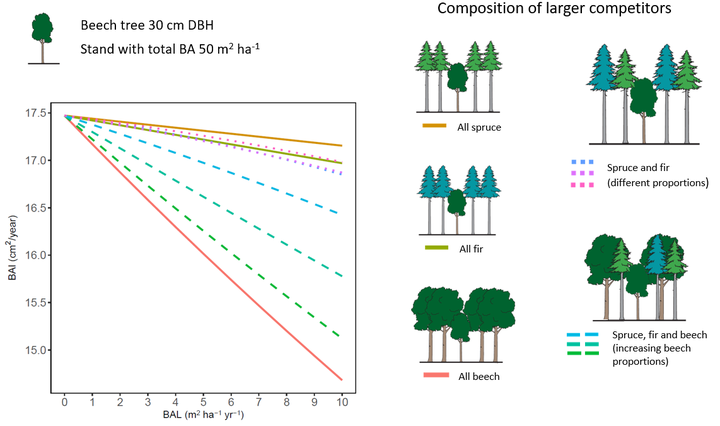The symmetry of competitive interactions in mixed Norway spruce , silver fir and European beech forests

Abstract
QUESTIONS. We aim for a better understanding of the different modes of intra and inter-specific competition in two- and three-species mixed forests. How can the effect of different modes of competitive interactions be detected and integrated into individual tree growth models? Are species interactions in spruce–fir–beech forests more associated with size‐symmetric or size‐asymmetric competition? Do competitive interactions between two of these species change from two‐ to three‐species mixtures? LOCATION. Temperate mixed‐species forests in Central Europe (Switzerland). METHODS. We used data from the Swiss National Forest Inventory to fit basal area increment models at the individual tree level, including the effect of ecological site conditions and indices of size‐symmetric and size‐asymmetric competition. Interaction terms between species‐specific competition indices were used to disentangle significant differences in species interactions from two‐ to three‐species mixtures. RESULTS. The growth of spruce and fir was positively affected by increasing proportions of the other species in spruce–fir mixtures, but negative effects were detected with increasing presence of beech. We found that competitive interactions for spruce and fir were more related to size‐symmetric competition, indicating that species interactions might be more associated with competition for below‐ground resources. Under constant amounts of stand basal area, the growth of beech clearly benefited from the increasing admixture of spruce and fir. For this species, patterns of size‐symmetric and size‐asymmetric competitive interactions were similar, indicating that beech is a strong self‐competitor for both above‐ground and below‐ground resources. Only for silver fir and beech, we found significant changes in species interactions from two‐ to three‐species mixtures, but these were not as prominent as the effects due to differences between intra‐ and inter‐specific competitio .CONCLUSIONS. Species interactions in spruce–fir–beech, or other mixed forests, can be characterized depending on the mode of competition, allowing interpretations of whether they occur mainly above or below ground level. Our outcomes illustrate that species‐specific competition indices can be integrated in individual tree growth functions to express the different modes of competition between species, and highlight the importance of considering the symmetry of competition alongside competitive interactions in models aimed at depicting growth in mixed‐species forests.